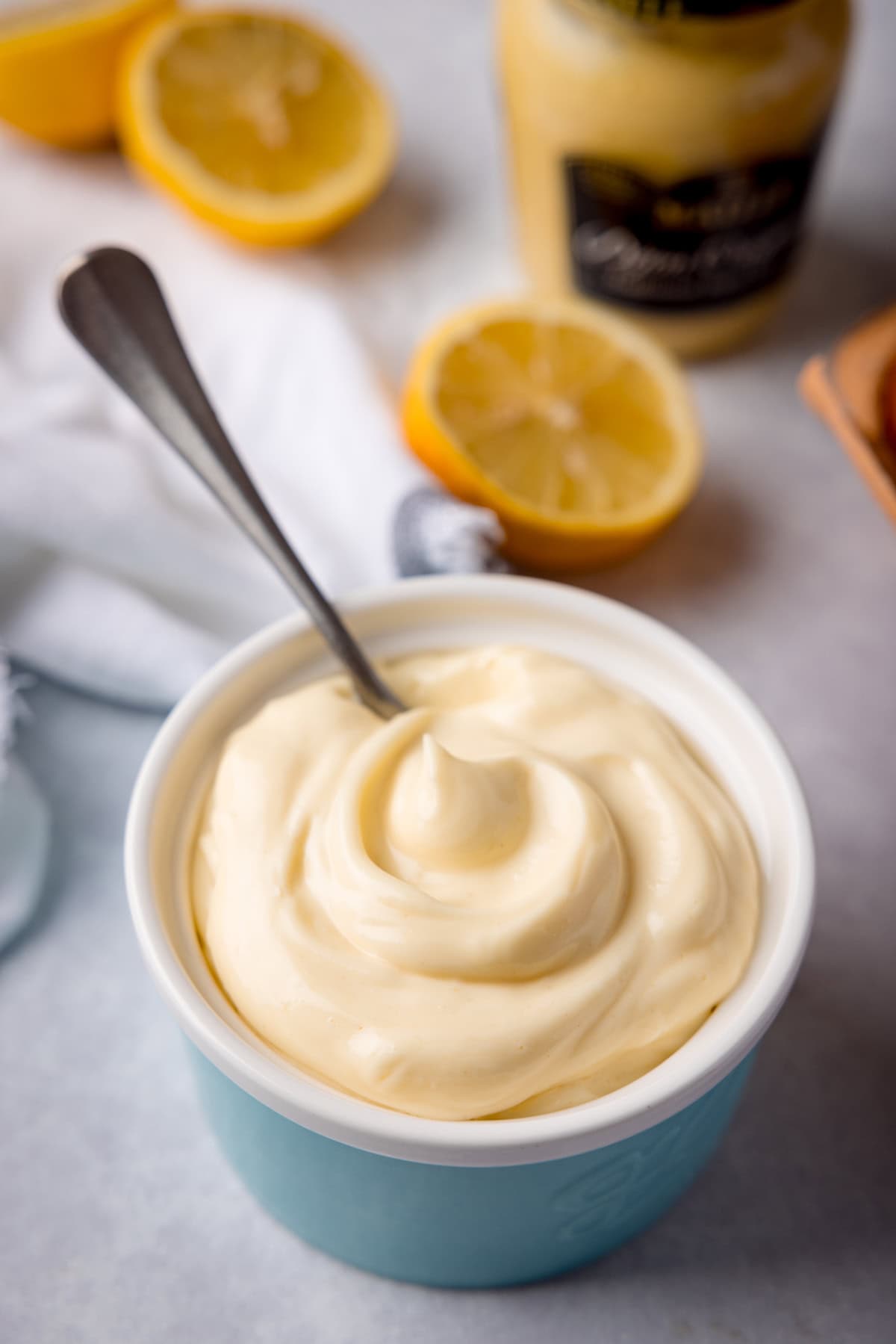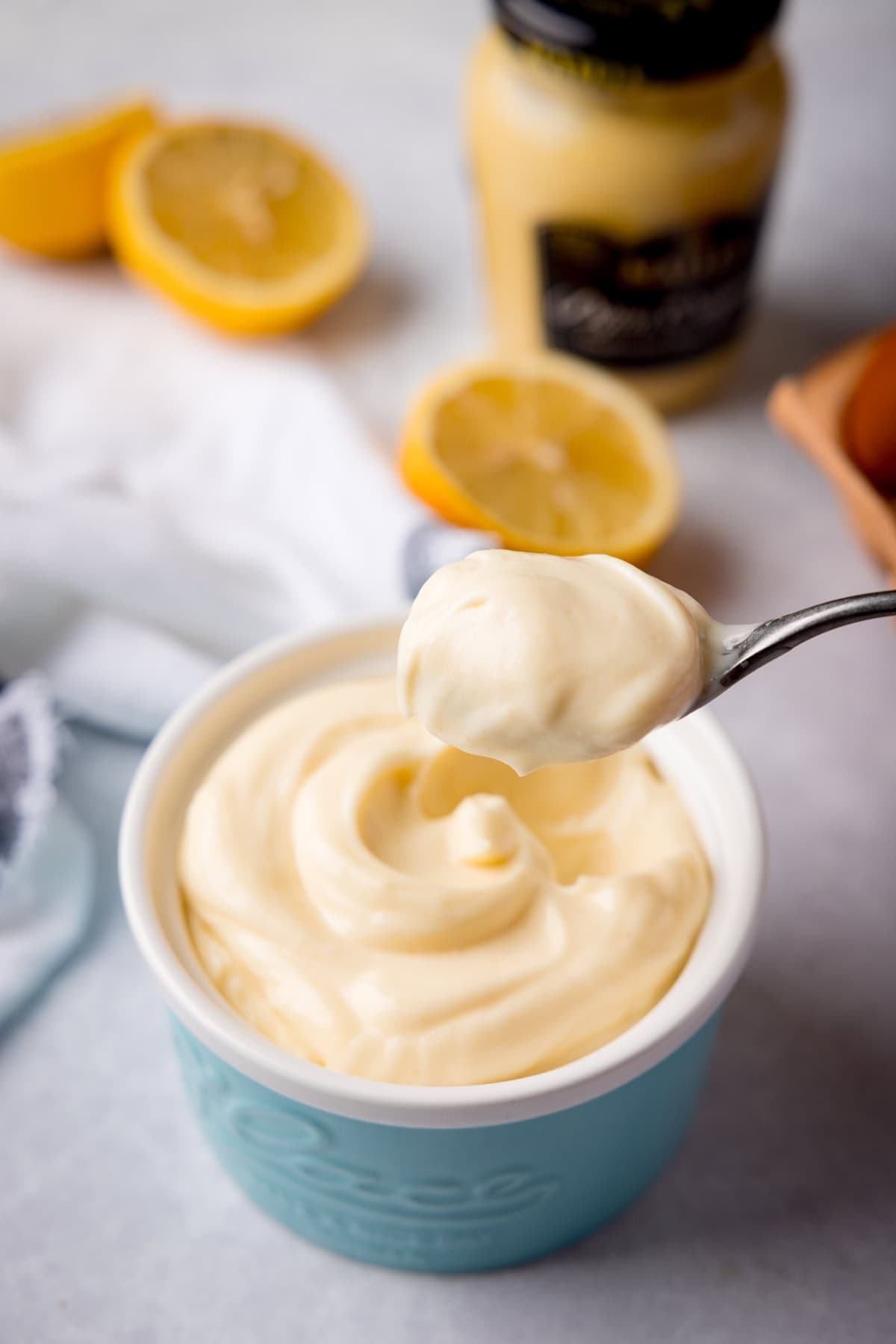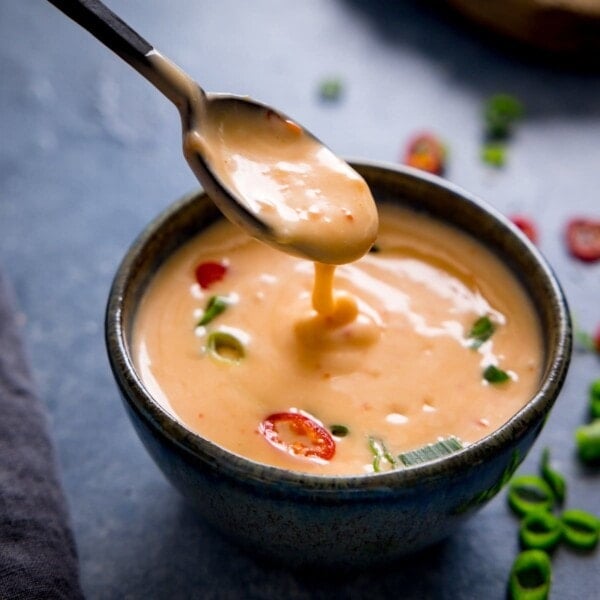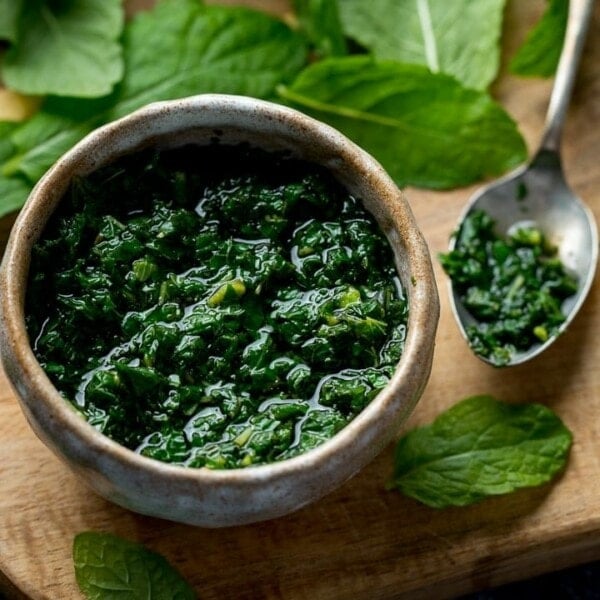The thought of making homemade mayo can be a bit overwhelming, especially when it’s so readily available to buy in the shops. Don’t worry though, I’ve got you covered! Easy steps to produce perfect luxurious homemade mayo that tastes far superior and isn’t full of strange ingredients!
I’ll show you how to make it in the food processor and using an immersion blender (this is my favourite method).

Slices of roast chicken, seasoned with a pinch of salt and pepper and sandwiched between two thick slices of fluffy bread that’ve been slathered in rich homemade mayo. That, my friends, is the stuff of dreams.
And also my lunch three times this week (yay for having lots jars of homemade mayo in the fridge from multiple rounds of testing!).
Table of Contents
📋 Ingredients

⬆️ Here are the ingredients for both the immersion and food processor method.
The lemon juice is optional (I prefer it without, but some people like a hint of tanginess). The Dijon mustard is not optional. Even if you’re not keen on mustard, it needs it. And the mayo won’t taste of mustard (I promise).
How to make it
***Full recipe with detailed steps in the recipe card at the end of this post***
- For the food processor method, we blitz the egg for a few seconds, then add everything but the oil and blitz again. Then we add the oil extremely slowly to the food processor, while the motor is running. It takes a few minutes, but it will come together.
- For the immersion blender method, add everything to the blender jug (make sure the jug is only just wider than the blender head – we need tight quarters for this to work). I like to add the oil last, so it’s sitting on top. Then blend. It comes together in just a few seconds. That’s why this is my favourite method!

Pro Tip
Make sure your egg is room temperature. If you forget to take your egg out of the fridge, place the egg in a cup and cover with warm water (approx. body temperature). Leave for 10 minutes, then use the egg.
Perfect thick and creamy mayonnaise that lasts for up to two weeks in the fridge.

Pin this now to find it later
Pin It🍽️ What to serve it with
- Chips! Air fryer chips, oven chips or even chippy chips
- As a dip for cheeseburger spring rolls, ham and cheddar croquettes or chicken tenders
- Slathered on a fish burger, chicken burger or this Korean steak sandwich
- Add to coleslaw, bang bang sauce, potato salad or coronation chicken for a luxury version.
What’s your favourite ‘served with mayo’ meal?

🍲 More creamy dips and sauces
Frequently Asked Questions
Cover the mayonnaise and store in the refrigerator for up to 2 weeks.
Whilst the egg yolk acts as an emulsifier and thickener in mayonnaise, egg white helps to lighten the mayonnaise and make at fluffier. The proteins in the egg white also acts as aa stabiliser, helping to further ensure the mayonnaise doesn’t split.
Having the egg at room temperature means the fat in the egg yolk is more melty (think how much softer butter or camembert is at room temp – it’s like that) this helps it to emulsify better with the oil and produces a thicker mayonnaise.
If you forget to take your egg out of the fridge, place the egg in a cup and cover with warm water (approx. body temperature). Leave for 10 minutes, then use the egg.
Stay updated with new recipes!
Subscribe to the newsletter to hear when I post a new recipe. I’m also on YouTube (new videos every week) and Instagram (behind-the-scenes stories & beautiful food photos).

Homemade Mayonnaise Recipe
Equipment
- Immersion blender and narrow immersion jug OR a food processor
Ingredients
- 1 large egg (yolk and white) at room temperature* see tip
- 1 level tablespoon Dijon mustard
- 2 teaspoons white wine vinegar
- ¼ tsp salt
- 180 ml (3/4 cup) neutral tasting oil. I like a mild avocado oil or rapeseed oil
- 1 tsp fresh lemon juice (optional)
Instructions
- You can use a small food processor or an immersion blender for this recipe.
Food Processor method:
- Add the egg to the processor bowl and blend for 5 seconds.1 large egg (yolk and white)
- Add the Dijon mustard, white wine vinegar and salt and blend for 10 seconds until completely combined.1 level tablespoon Dijon mustard, 2 teaspoons white wine vinegar, 1/4 tsp salt
- Turn on the food processor to a low-medium speed and very slowly pour in the oil. Start with a drip at a time for about 10 drips, then pour in a very thin stream until the oil is added and the mixture has emulsified. It should be quite thick.180 ml (3/4 cup) neutral tasting oil.
- Taste the mayonnaise. If you want a little more fresh tang to it, add the lemon juice, and blend again.1 tsp fresh lemon juice
Immersion blender method:
- Ensure your blender jug is only a tiny bit wider than your blender tool. Immersion blender mayonnaise needs a confined space to emulsify properly – so don’t use a random jug.
- Add the egg, Dijon mustard, white wine vinegar and salt to the blender jug.1 large egg (yolk and white), 1 level tablespoon Dijon mustard, 2 teaspoons white wine vinegar, 1/4 tsp salt
- Pour the oil on top.1 large egg (yolk and white)
- Sit the immersion blender in the mixture and turn it on to full speed whilst holding the jug tightly.
- Move the blender tool up and down while blending until the mixture has emulsified and thickened.
- Taste the mayonnaise. If you want a little more fresh tang to it, add the lemon juice, and blend again.1 tsp fresh lemon juice
Notes
Storage:
Cover the mayonnaise and store in the refrigerator for up to 2 weeks.My mayonnaise is too thin
Add an egg yolk to the mayonnaise and blend again. Egg yolk acts as an emulsifier and thickener, so should thicken the mayonnaise.My mayonnaise is too thick
Blend the mayonnaise whilst adding in drops of warm water. It thins quickly, so you should only need ½ teaspoon or so to thin it out.My mayonnaise is greasy
Blend the mayonnaise whilst adding in drops of warm water. This should help reduce the greasiness. Water will also thin out the mayonnaise, so only use 1/4-1/2 teaspoon.If you feel the mayonnaise needs more tanginess, replace the water with fresh lemon juice (no need to warm it).
Why use egg white in mayonnaise?
Whilst the egg yolk acts as an emulsifier and thickener in mayonnaise, egg white helps to lighten the mayonnaise and make at fluffier. The proteins in the egg white also acts as aa stabiliser, helping to further ensure the mayonnaise doesn’t split.How to fix broken/split mayonnaise
Add a tablespoon of boiling water to the mixture and blend again. Note: it will be a little thinner with the added water.If you want to thicken it, you can add an extra egg yolk (once you’ve blended in the boiling water) and blend again.
Why does the egg need to be at room temperature?
Having the egg at room temperature helps the egg yolk to emulsify better with the oil and produces a thicker mayonnaise.If you forget to take your egg out of the fridge, place the egg in a cup and cover with slightly warm water (approx. body temperature). Leave for 10 minutes, then use the egg. Nutritional information is approximate, per tablespoon. This recipe makes approx. 16 tablespoons.
Nutrition
Nutrition information is automatically calculated, so should only be used as an approximation.
Some of the links in this post may be affiliate links – which means if you buy the product I get a small commission (at no extra cost to you). If you do buy, then thank you! That’s what helps us to keep Kitchen Sanctuary running. The nutritional information provided is approximate and can vary depending on several factors. For more information please see our Terms & Conditions.






















